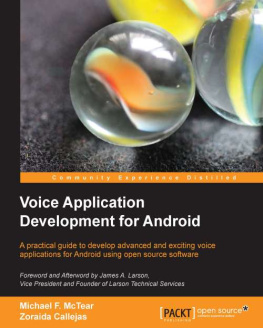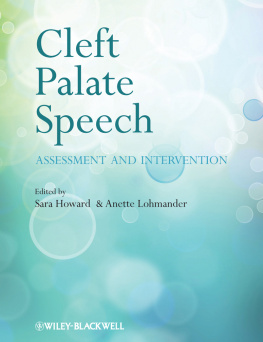Speech and Voice Science
FOURTH EDITION
Speech and Voice Science
FOURTH EDITION
Alison Behrman, PhD, CCC-SLP
With a Contribution by Donald Finan, PhD


5521 Ruffin Road
San Diego, CA 92123
e-mail:
Website: https://www.pluralpublishing.com
Copyright 2023 by Plural Publishing, Inc.
Typeset in 11/13 Garamond Book by Flanagans Publishing Services, Inc.
Printed in the United States of America by McNaughton & Gunn, Inc.
All rights, including that of translation, reserved. No part of this publication may be reproduced, stored in a retrieval system, or transmitted in any form or by any means, electronic, mechanical, recording, or otherwise, including photocopying, recording, taping, Web distribution, or information storage and retrieval systems without the prior written consent of the publisher.
For permission to use material from this text, contact us by
Telephone: (866) 758-7251
Fax: (888) 758-7255
e-mail:
Every attempt has been made to contact the copyright holders for material originally printed in another source. If any have been inadvertently overlooked, the publisher will gladly make the necessary arrangements at the first opportunity.
Disclaimer: Please note that ancillary content (such as documents, audio, and video, etc.) may not be included as published in the original print version of this book.
Library of Congress Cataloging-in-Publication Data
Names: Behrman, Alison, author. | Finan, Donald, author.
Title: Speech and voice science / Alison Behrman, with a contribution by Donald Finan.
Description: Fourth edition. | San Diego, CA: Plural Publishing, Inc., [2023] | Includes bibliographical references and index.
Identifiers: LCCN 2021011279 (print) | LCCN 2021011280 (ebook) | ISBN 9781635503227 (paperback) | ISBN 9781635503234 (ebook)
Subjects: MESH: Speech--physiology | Voice--physiology | Case Reports
Classification: LCC QP306 (print) | LCC QP306 (ebook) | NLM WV 501 | DDC 612.7/8--dc23
LC record available at https://lccn.loc.gov/2021011279
LC ebook record available at https://lccn.loc.gov/2021011280
Contents
!
Chapter 4. Breathing
Clinical Case 1: Breath-Holding Speech
An adult bilingual woman is having difficulty making herself heard in a noisy work environment and feels that talking is hard work. The evaluation by the speech-language pathologist (SLP) reveals inefficient speech breathing strategies. Features of speech breathing are addressed.
Clinical Application: Disorders Related to Breathing
An overview of breathing disorders that can impact speech production is presented, including categories of etiology, symptoms, diagnostic strategies, and therapeutic approaches. The connection between speech breathing problems and the anatomy and physiology of breathing is emphasized.
Chapter 5. Phonation I: Basic Voice Science
Clinical Case 2: Running Out of Breath
An adult woman with a functional voice disorder is seen for a voice evaluation. Factors that contribute to inefficient voice production are addressed.
Clinical Application: Disorders Related to Voice Production
An overview of voice disorders is presented, including categories of etiology, symptoms, diagnostic strategies, and therapeutic approaches. The connection between voice disorders and the anatomy and physiology of voice production is emphasized.
Chapter 6. Phonation II: Measurement and Instrumentation
Clinical Case 3: Camp Voice
A fourth grader with a voice disorder due to excessive voice use is seen for voice therapy. The relationship between voice production and voice quality is addressed.
Clinical Case 4: Persistent Mutational Falsetto
A teenage boy with persistence of prepuberty pitch and voice quality is seen for voice therapy. Differences in pre- and postpuberty vocal characteristics in boys are addressed.
Chapter 7. The Production and Perception of Vowels
Clinical Case 5: Accent Management
An adult whose first language is Spanish wants to improve his pronunciation in English for his job as a reading specialist. An SLP conducted accent management therapy with a focus on differences in tense-lax vowel production. Acoustic features of tense and lax vowels are referenced.
Clinical Case 6: Ataxic Dysarthria
A man with Friedreichs ataxia, a progressive disease, had difficulty coordinating the movements for articulation and voice production. The combined effects of both a speech and voice disorder are addressed.
Chapter 8. The Production and Perception of Consonants
Clinical Case 7: Facial Nerve Trauma
An adult with trauma to the facial nerve has speech and swallowing difficulties. The therapy included strategies to increase oral articulatory movements for improved phoneme production. Acoustic cues for consonant production and the effect upon prosody are addressed.
Clinical Application: Speech Sound Disorders
An overview of disorders of articulation of consonants is presented, including categories of etiology, symptoms, diagnostic strategies, and therapeutic approaches. The connection between articulation problems and the physiology and acoustics of consonant production is emphasized.
Clinical Case 8: Articulation Errors
A boy with articulation errors receives speech therapy in school. The SLP includes feedback on the differences in pitch between correct and incorrect production of /s/. Acoustic cues for fricative production are addressed.
Chapter 9. Prosody
Clinical Case 9: Parkinsons Disease
A bilingual (Mandarin/English) adult with Parkinsons disease receives speech therapy to work on the decreased speech intensity and prosody that has increasingly interfered with his ability to make himself easily understood. Prosody is addressed within the context of a tonal (Mandarin) and nontonal (English) language.
Clinical Case 10: Gender-Diverse Speech and Voice
An adult in the process of transitioning from male to female receives speech therapy to help her express the voice and speech characteristics that help her to feel authentic. Those characteristics and the therapeutic approach are discussed.
Chapter 10. Theories and Models of Speech Production
Clinical Case 11: Spastic Cerebral Palsy
A child with spastic cerebral palsy receives speech therapy to decrease the extra effort of speaking and increase speech clarity. Rate of speech and coarticulation are addressed within the context of the dysarthria (motor speech disorder).
Clinical Case 12: Oral Motor Exercises
A teenager with head trauma and subsequent right-sided weakness receives speech therapy to improve her articulation. The controversial topic of nonspeech oral motor exercises is addressed within the context of motor learning theory.







